|
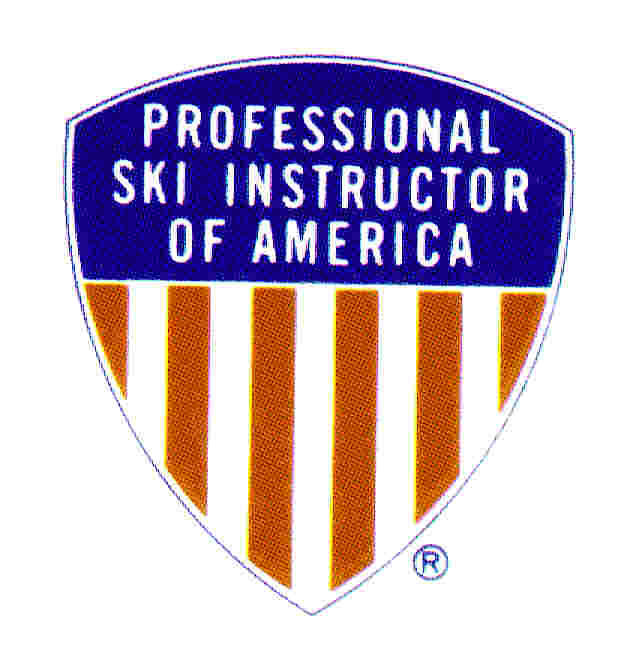
| |
Did you come here from a link on another website? See page bottom for latest version of this page.
This site is not associated with any ski area. Use of any page
means you accept the SkiMyBest Site Use
Agreement or
EXIT NOW.
Back to "How To Reserve Private Ski Lessons with Bill Jones"
bill JONES's annual ski letter 2019-2020
by Bill Jones, Ski Instructor
Certified Professional Ski Instructor (Registration #110478), Level III
private ski lessons at Vail Resort ski areas of Keystone, Breckenridge, Vail, Beaver Creek/Arrowhead,
and at other areas
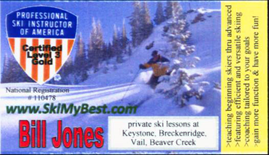 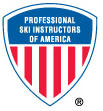
BILL JONES’ SKI LETTER 2019-2020
Skiing is well underway in Summit County, Colorado, and what a winter it has been already. So far I have skied 51 days including teaching, skiing in updating clinics, and just skiing. I expect to be well over my norm of some 100 days per winter. Come join the fun!
I will again be instructing as an employee of Vail Resorts (the company now lists over 30 ski resorts) and will once more be based at the ski school at Keystone but also able to teach private lessons at other Vail Resorts areas such as Breckenridge, Vail, and Beaver Creek. Get information on booking at www.keystoneresort.com or call the Keystone Ski School at 1/800-255-3715. See my website www.skimybest.com with its included ski manual “Skiing is a Sliding Sport”, email me at billjones@skimybest.com, or call me at 970/468-7673.
I’d love to ski with you and/or ski with you again and help you get to your next level of skiing fun.
Earlier I posted this invitation on my website as BILL JONES’ SKI LETTER 2019, along with some pertinent skiing tips such as
“Ski Styles: Double-Edge Death Grip, "Lock-and Step", and Glider” including the video PSIman which shows a little stick figure on skis how little we have to do to make our skis turn. (There’s the new Episode II, too, if you have already amused yourself with this.)
“Ski Boot Prep” where ideas about ski boots are shared, timely because it seems the importance of having a boot with a cuff that can flex forward is again showing up as a limiting factor for skiing students who want to ski better.
“Tip Forward They Say. Why?”
And “It Depends”
See the letter and these tips at www.skimybest.com/skiletter 2019-2020.html.
Bill Jones, 37th year helping skiers in Colorado ski better to have more fun
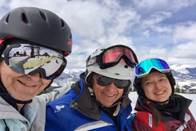
SKI STYLES: “Double-edge Death Grip”, “Lock and Step”, “Glider”
By Bill Jones
My business ski card carries this motto:
“featuring efficient and versatile skiing…gain more function and have more fun”.
There are lots of ways to ski. Is there is a way to ski more hours and more days and more years and have more fun longer?
Some years ago a ski instructor stood beside a moderate ski slope and watched skiers coming down, classifying them by how they skied. He found four styles. The fourth style is a special case so here we will deal with the three that form a continuum in the evolution of many if not most skiers. If you have skied with me in a lesson, you may have heard me explain these styles. All have their purpose as managing the speed and direction a skier is going, often called control.
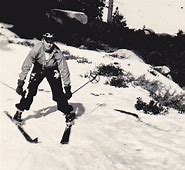 Style 1: “Double-edge Death Grip”—This skier is fearful of sliding down the hill so has learned to position the skis in a V with the point of the V downhill and the arms of the V widening out to the back, aka “snowplow”. In this the skis tip up on the sides that are away from the skier’s center so their edges scrape against the snow. This scraping creates friction that--if the slope is not too steep—will slow or stop the skier. The wider the V the more the friction and therefore the more the slowing or sooner the stopping. But also the wider the V the more the skis tip on their sides that are under the skier and dig into the snow and the harder they are to turn. The position is awkward for the body and demanding of the legs. Style 1: “Double-edge Death Grip”—This skier is fearful of sliding down the hill so has learned to position the skis in a V with the point of the V downhill and the arms of the V widening out to the back, aka “snowplow”. In this the skis tip up on the sides that are away from the skier’s center so their edges scrape against the snow. This scraping creates friction that--if the slope is not too steep—will slow or stop the skier. The wider the V the more the friction and therefore the more the slowing or sooner the stopping. But also the wider the V the more the skis tip on their sides that are under the skier and dig into the snow and the harder they are to turn. The position is awkward for the body and demanding of the legs.
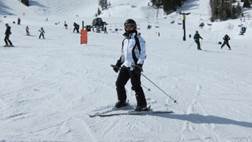
Style 2: “Lock and Step”—This skier is less fearful of sliding down the hill than the Style 1 skier, yet still wants to keep some grip on the snow at all times. Having learned in Style 1 that tipped skis provide such a grip, but make it hard to turn the skis, the Style 2 skier has learned to untip the uphill ski making its base flat to the snow and thus giving up its grip while keeping the ski that is downhill tipped and anchored. To turn, Style 2 skiers step or slide the uphill ski forward and around the anchored downhill ski to turn. Style 2 skiers can get so proficient at this movement that they can do it well even with skis parallel. But “lock and step” is still more athletic than necessary and adds some motions that take time to do and so take time from needed motions. It also produces less functional positions of the body as skiing speeds, terrain, and snow textures become more challenging.
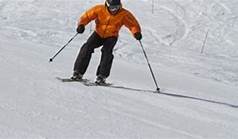 Style 3: “Glider”-This skier in preparation for a turn positions both skis so their bases are flat on the snow. This gives the options of turning them together so they stay parallel or tipping the skis onto their other sides so the skis do the turning (aka “carving”). Most of the movements of the glider occur in the feet, ankles, and lower legs, with the upper body and arms providing a stable mass for the lower to work against. It is possible to become a glider without going through “Double-edge Death Grip” and “Lock and Step” stages, or at least minimizing time spent in them by learning on slopes gentle enough to be willing to loosen one’s grip on the snow in the early phases of one’s skiing development. (Unfortunately, many aspiring skiers are too anxious to “ski the mountain” and skip this step of learning, compromising them reaching their potential skill level.) Style 3: “Glider”-This skier in preparation for a turn positions both skis so their bases are flat on the snow. This gives the options of turning them together so they stay parallel or tipping the skis onto their other sides so the skis do the turning (aka “carving”). Most of the movements of the glider occur in the feet, ankles, and lower legs, with the upper body and arms providing a stable mass for the lower to work against. It is possible to become a glider without going through “Double-edge Death Grip” and “Lock and Step” stages, or at least minimizing time spent in them by learning on slopes gentle enough to be willing to loosen one’s grip on the snow in the early phases of one’s skiing development. (Unfortunately, many aspiring skiers are too anxious to “ski the mountain” and skip this step of learning, compromising them reaching their potential skill level.)
Occasionally I have gone out as the above ski instructor did to stand beside ski runs to see how many skiers use each of these styles. Clearly style 1, “Double-edge Death Grip” is favored only in the earlier learning stagers and sometimes on intermediate slopes by few adults who seem to struggle and some children. Style 2 “Lock and Step” skiers dominate in numbers and stand out by how they swing their arms, shoulders, and hips, often sort of punching forward in the air with the hand and arm that is on the outside of their turn. Style 3 “Gliders” are in the minority or absent on the easier slopes. But when some appear there or on steeper slopes, they move their bodies little but perhaps tipped to the side of their skis; they seem to be descending as if by magic in smooth arcs, looking graceful, and sometimes going fast.
Let us “skimybest” and be gliders.
But here’s the deal: To let go of the skis’ edges so the skis bases are flat on the snow can feel like one is losing the feeling of control from their anchor. That is because one is. To be a glider you must let go of the mountain, getting rid of the locked edge as in Styles 1 and 2. A noted earlier, you can work up to this by learning to do this on gentle slopes. You can also be coached with drills that can help you get to this point in progressive steps. The trouble is that “to be balanced well on the middles of your skis you must position your body so it is generally perpendicular (at a right angle) to your skis and the slope they are on. Thus when your skis are at the point where they are pointed downhill in a turn you are tilted at an angle that puts your head forward of your feet, a position most humans find counter to their intuitions, having dealt with the vertical pull of gravity all their lives.
Because letting go of the mountain is psychologically uncomfortable, many skiers as they learn to ski are taught instead to use the “lock and step” style. They are told, from a stance where both skis are tipped on their edges, to shift more weight onto one ski, perhaps caused by bending an ankle or knee on that side. Such a method works on gentler slopes. However, it encourages them to start turns by advancing the side of the body that is uphill, a habit that takes effort to do. Turning effectively and efficiently and especially on steeper slopes, however, demands we start turns by advancing the downhill side of the body, just opposite of the way many are initially taught in “lock and step”. Gliding this way uses ski design and gravity as well as positive human anatomy and thus takes less effort and is more effective in more situations.
 For many skiers, the “lock and step” style is all they need and want. But to become more efficient as to ski more hours in the day and more days on the ski trip—as well as more terrain and snow conditions and with more fun—they should aspire higher and become a glider. What is your take? For many skiers, the “lock and step” style is all they need and want. But to become more efficient as to ski more hours in the day and more days on the ski trip—as well as more terrain and snow conditions and with more fun—they should aspire higher and become a glider. What is your take?
_____________________________________________________________________________________
See some images of world-class gliders from www.ronlemaster.com (and learn about Ron’s book Ultimate Skiing.) For instance, look at http://ronlemaster.com/public_images/posted-03-15-2017/.
We won’t ski as aggressively as these champions but the photo-montage pictures help us understand the mechanics of gliding. See where in the turns the ski are tipped and where they are flat on the snow and also observe the tilt of the skiers’ bodies typically perpendicular to the bases of their skis and sometimes tipped downhill.
And, if you haven’t yet taken a look at PSIman, the little stick figure on shaped skis, you owe it to yourself to really appreciate and understand how little we have to do to make our skis turn. See it here: https://vimeo.com/9872613. If you already have seen PSIman take a look at Episode II: https://www.bing.com/videos/search?q=psiman&view=detail&mid=612FB1292B1BA1D03940612FB1292B1BA1D03940&FORM=VIRE
Once you have viewed PSIman’s skiing you will better understand what this wise skier said,
"In skiing, there are things (positions, movements, pressures) that we create and things that we allow; we should not create those things we could and should allow."
SKI BOOT PREP
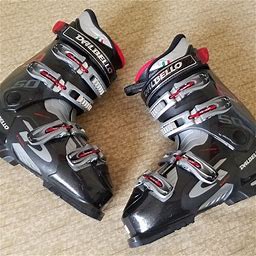 Do you own your ski boots? Do you own your ski boots?
As a reminder, if you own your boots and have not worn them since last ski season, the flow material in the liner has probably flowed into positions that may have less to do with the shape of your foot than it had on your last ski day. Reshape your boots to your feet by first warming them up indoors, then wearing them in that same warm place for 20 minutes or more until the fit feels right to you. Enhance the flow of the material into the shape that fits you by walking a bit in the boots and/or flexing the boots by bending and unbending your ankles and knees. Also do this before any ski trip if there is a week or so between uses. And have the boots warm when you put them on before skiing, too, so any last-minute conforming will be made.
Do you rent ski boots?
Rented boots will best fit the person’s foot who last rented them, and probably not your foot as foot shapes differ from person to person. So, rent your boots at least by the evening before your ski days so you can go through the same exercise as above.
Whether you own or rent ski boots—
One of the movements we can do while skiing--in order to position and pressure the skis so they will perform--is extending upwards and flexing downwards, ‘though not necessarily vertically (see “Tip Forward…” below). Our hip, knee, and ankle joints allow us to change the angles of our leg bones so we can do this. In our ski clothes our hips and knees are free to move as they always do, but our ankles are encased in our boots and bending them is impeded. Still, our boots have hinges at the sides of the ankles (that big round object on both sides of boots) so they can bend.
Do you ski fast and steep with sharp turns? Even in stiff boots, you will develop enough pressure to cause your boots to flex at their hinges so that your ankles will flex along with your other joints and allow you to keep even pressure along your feet and therefore your skis, a desirable base position.
But if you ski less aggressively but in stiff boots, the firmer hinge will impede bending your ankles and if you flex, your knee will bend more than your ankle, putting more weight on the back parts of your skis and compromising your performance. Use a pair of boots that you can bend forward when you flex downward, with softer flexes for less aggressive skiing. Such a boot that allows you to bend at the ankles so you can also bend in balance at the knees will allow you to move your legs inward and outward to have more range in the angles at which you can tip your skis.
Not long ago it was conventional wisdom that boots should be stiff to perform well. Now manufacturers give numerical values to their boot models so you can select the stiffness level best for you. Values range between about 50 (very soft) and 140 (extremely stiff). These values may not be assigned the same way by different manufacturers but are a general guide.
Although you want boots that allow you to bend them forward depending on your skiing style, you still want your boots to be stiff laterally so that when you tip skis onto their sides the boots will hold the skis firmly in line with your legs.
After skiing
Buckle your boots so they have a better chance of retaining the shape of your feet. And have them in a warm place overnight so any moisture inside will dry out and not make your feet cold the next time you ski. And/or use a boot dryer that you insert into the boots.
TIP FORWARD THEY SAY. WHY?
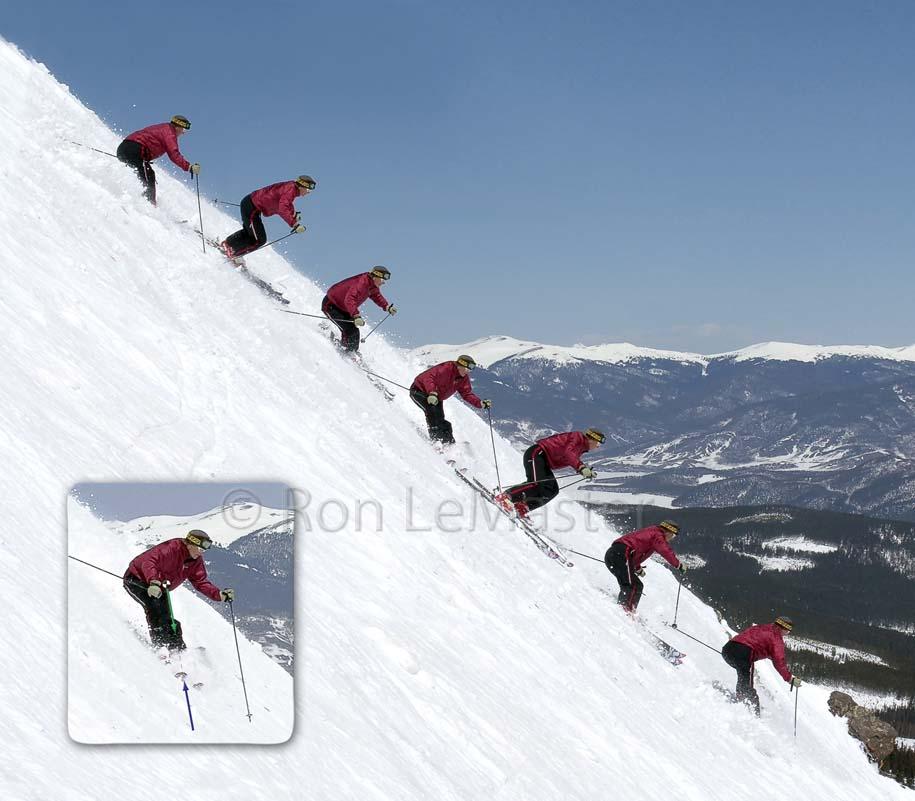
Besides hearing ski instructors coach their students to “Look up” instead of down at their ski tips, perhaps the most common sounds on the learning ski slopes are instructors saying “Tip forward”. Why do they say this? And how does one tip forward? And when? Always? Or sometimes?
When we stand on our skis in their middles, our weight is distributed along the lengths of the skis. This is because most recreational skis are shaped with a lengthwise arch (called base camber)—when skis are put base to base the tips and tails touch but not the middles. This is like our feet, which for most of us are also arched, helping us balance better. On skis the arches also ensure the entire lengths of our skis’ sides will have similar pressure so their edges will engage the snow along their whole lengths and thus better scrape the snow to create friction to slow us or press into the snow when tipped so as to turn us.
When on a flat surface or traversing sideways across a ski slope (or even in the transition zone between two ski turns when we may also be in a position sideways on the hill), there is little or no need to tip forward to achieve an even pressure distribution along the skis’ lengths. We can stay mainly vertical in such situations. But when we point our skis down the hill, matters change. If we remain vertical (as in the picture of the skier in orange pants), more of our weight will press on our heels and therefore on the tails of the skis. When we try to turn our skis, the skis’ tails will tend to dig into the snow behind us, impeding turning and perhaps making us step the skis to make them turn. It’s also like we are pushing the skis away from us down the hill, leaving us unbalanced to the back. But if we tip downhill in this situation so that our bodies remain perpendicular to the slope and our skis, we will be more likely to again have the skis evenly pressured along their lengths and not have their tails get caught when turning. press on our heels and therefore on the tails of the skis. When we try to turn our skis, the skis’ tails will tend to dig into the snow behind us, impeding turning and perhaps making us step the skis to make them turn. It’s also like we are pushing the skis away from us down the hill, leaving us unbalanced to the back. But if we tip downhill in this situation so that our bodies remain perpendicular to the slope and our skis, we will be more likely to again have the skis evenly pressured along their lengths and not have their tails get caught when turning.
Give some thought to what one must do to tip forward when the skis point downhill. Such a position is opposite to how we normally stand. We do not walk around in such a way that if our nose runs it won’t drip on our toes! To get forward requires that we move there. It does not happen by itself. We must be willing and able to do that. Ways to move forward include first flexing our ankles so that our bodies sink a bit and then pushing on our feet to extend upward and forward the correct amount to match the steepness of the ski slope we are on. Ideally we should aim our movement so that we stand perpendicular to our skis on whatever slope we are on.
There is more to why we should tip forward on a slope while skiing. Normally as we walk we are perpendicular to our feet. That is, the two lower leg bones are nearly at right angles to our foot bones. In that position, we can best tip our feet to either side (a move in skiing called edging) and turn them (a move in skiing called foot steering or turning). If our leg bones are not adequately perpendicular to our foot bones, both these motions are inhibited, and if we are on skis our turns are inhibited, too. This is because of a little bone in the angle between the fronts of our legs and our feet, at our ankles. If our leg bones are not perpendicular to our feet, this bone moves into a spot that inhibits the twisting of our lower leg bones and the tilting of our feet and if we are on skis, inhibits turning and edging them.
Do you need to know all this to ski well? Of course not. Perhaps, though, knowing it will encourage you to strive to overcome natural inhibitions to tip down hills and become in most cases perpendicular to your skis whether on the flats or a steep slope so you can ski better and have more fun.
IT DEPENDS
Recall that all questions about and discussions of skiing are best first answered with “It depends” because there are many variations of skis, boots, snows, slopes, skiers, and intentions.
Thanks for reading. I hope it will make skiing still more fun.
Bill Jones
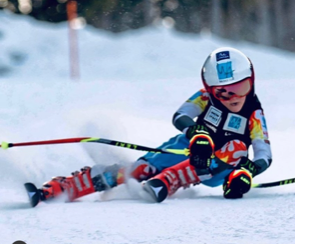 a 6-year old a 6-year old
Back to "How To Reserve Private Ski Lessons with Bill Jones"
This "Bill's Annual Ski Letter 2019-2020
page
last modified January 22, 2020. Did you come here from a link on another website?
For latest version of this page, copy to your browser: http://www.SkiMyBest.com/skki letter 2019-2020.html.
Copyright © 2013, 2014, 2015, 2016, 2017, 2018, 2019, 2020. William R Jones.
|
|

|